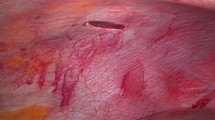Abstract
Background
General surgeons’ recent familiarity with advanced laparoscopic techniques have rendered laparoscopy feasible safely in the trauma setting. Traditionally high rates of nontherapeutic laparotomies also contribute to this increased interest. This study was undertaken to determine the predictive value and accuracy of diagnostic laparoscopy (DL) in evaluation of penetrating thoracoabdominal trauma.
Methods
Entry criteria included thoracoabdominal gunshot (GSW) or stab wounds (SW) in otherwise hemodynamically stable patients. A high index of suspicion for either hemoperitoneum, peritonitis, or diaphragmatic injury was required for inclusion. All patients underwent DL in the operating room followed by standard laparotomy. The findings of the two evaluations were compared.
Results
Twenty-four patients were included in the study. Twenty males and 4 females with an average age of 34 years made up the group. Violation of the peritoneal cavity was present in 21 cases and absent in 3. No intraabdominal injuries were found during laparotomy in the latter three cases without peritoneal violation. The specificity and positive predictive value were 100% for lesions of the diaphragm, liver, spleen, pancreas, kidney, and hollow viscus. The sensitivity was highest for liver and spleen injuries (88%), followed by diaphragmatic injuries (83%), pancreas and kidney injuries (50%), and lowest for injuries of hollow viscus (25%). The negative predictive value was 95, 99, 91, and 57%, respectively, for these organs.
Conclusions
DL could have avoided unnecessary laparotomy in 38% of cases in this study. There were no complications related to laparoscopy. The greatest value of DL in penetrating thoracoabdominal injuries is in the evaluation of peritoneal violation, diaphragmatic, and upper abdominal solid-organ injuries. It is not ideal for predicting hollow viscus injuries.
Similar content being viewed by others
References
Berci G, Sackier JM, Partlow MP (1991) Emergency laparoscopy. Am J Surg 161: 332–335
Brandt CP, Priebe PP, Jacobs DG (1994) Potential of laparoscopy to reduce nontherapeutic trauma laparotomies. Am Surg 6: 417–420
Demetriades D, Kakorjiannis S, Parekh D, Hatzitheofilou C (1988) Penetrating injuries of the diaphragm. Br J Surg 75: 824
Demetriades D, Rabinowitz B (1987) Indications for operation in abdominal stab wounds. Ann Surg 205: 129–132
Fabian TC, Croce MA, Steward RM, Pritchard FE, Minard Ag, Kudsk KA (1993) A prospective analysis of diagnostic laparoscopy in trauma. Ann Surg 217: 557–565
Fernando HC, Alle KM, Davis CI, Klein SR (1994) Triage by laparoscopy in patients with penetrating abdominal trauma. Br J Surg 81: 384–385
Ivatury RR, Simon RJ, Stahl WM (1993) A critical evaluation of laparoscopy in penetrating abdominal trauma. J Trauma 34: 822–828
Ivatury RR, Simon RJ, Weksler M, Bayard V, Stahl WM (1992) Laparoscopy in the evaluation of the intrathoracic abdomen after penetrating injury. Trauma 33: 101–109
Josephs LG, Este-McDonald JR, Birkett DH, Hirsch EF (1994) Diagnostic laparoscopy increases intracranial pressure. J Trauma 36: 815
Livingston DH, Tortella BJ, Blackwood J, Machiedo GW, Rush BJ (1992) The role of laparoscopy in abdominal trauma. J Trauma 33: 471–475
Moore EE, Moore JB, Moore SV, Thompson JS (1980) Mandatory laparotomy for gunshot wounds penetrating the abdomen. Am J Surg 140: 847–850
Rossi P, Mullins D, Thal E (1993) Role of laparoscopy in the evaluation of abdominal trauma. Am J Surg 166: 707–711
Salvino CK, Esposito TJ, Marshall WJ, Dries DJ, Morris RC, Gamelli RL (1993) The role of diagnostic laparoscopy in the management of trauma patients: a preliminary assessment. J Trauma 34: 506–515
Shorr RM, Gottlieb MM, Webb K, Ishigura L, Berne TV (1988) Selective management of abdominal stab wounds. Arch Surg 123: 1141–1145
Sosa JL, Baker M, Puente I, Sims D, Sleeman D, Ginzburg E, Martin L (1995) Negative laparotomy in abdominal gunshot wounds: potential impact of laparoscopy. J Trauma 38: 194–197
Taylor FW (1973) Gunshot wounds of the abdomen. Ann Surg 177: 174
Thal ER (1977) Evaluation of peritoneal lavage and local exploration of lower chest and abdominal stab wounds. Trauma 17: 642
Townsend MC, Flancbaum L, Chaban PS, Cloutier CT (1993) Diagnostic laparoscopy as an adjunct to selective conservative management of solid organ injuries after blunt abdominal trauma. J Trauma 35: 647–653.
Author information
Authors and Affiliations
Additional information
This study was funded by a grant from Karl Storz (Culver City, CA) Presented at the annual meeting of the Society of American Gastrointestinal Endoscopic Surgeons, (SAGES), Orlando, Florida, USA, 11–14 March 1995
Rights and permissions
About this article
Cite this article
Ortega, A.E., Tang, E., Froes, E.T. et al. Laparoscopic evaluation of penetrating thoracoabdominal traumatic injuries. Surg Endosc 10, 19–22 (1996). https://doi.org/10.1007/s004649910003
Received:
Accepted:
Issue Date:
DOI: https://doi.org/10.1007/s004649910003




